An Effective Method for Preparation of Liquid Phosphoric Anhydride and Its Application in Flame Retardant Epoxy Resin
Abstract
:1. Introduction
2. Experimental
2.1. Materials
2.2. Preparation of LPFA
2.3. Preparation of Flame Retardant Bisphenol-A Epoxy Resin
2.4. Measurement and Characterizations
3. Results and Discussion
3.1. Structures Characterization with FT-IR
3.2. MS Characterization
3.3. NMR Characterization
3.4. Flammability of Cured Epoxy Resins
3.5. Thermal Stability Analysis
3.6. Mechanical Properties Analysis
4. Conclusions
Author Contributions
Funding
Institutional Review Board Statement
Informed Consent Statement
Data Availability Statement
Conflicts of Interest
References
- Kumar, S.; Krishnan, S.; Mohanty, S.; Nayak, S.K. Synthesis and characterization of petroleum and biobased epoxy resins: A review. Polym. Int. 2018, 67, 815–839. [Google Scholar] [CrossRef]
- Jin, F.-L.; Li, X.; Park, S.-J. Synthesis and application of epoxy resins: A review. J. Int. Eng. Chem. 2015, 29, 1–11. [Google Scholar] [CrossRef]
- Ma, T.; Li, L.; Liu, T.; Guo, C. Synthesis of a caged bicyclic phosphates derived anhydride and its performance as a flame-retardant curing agent for epoxy resins. Polym. Adv. Technol. 2019, 30, 1314–1324. [Google Scholar] [CrossRef]
- Kim, I.J.; Ko, J.W.; Song, M.S.; Cheon, J.W.; Lee, D.J.; Park, J.W.; Yu, S.; Lee, J.H. Thermal and Flame Retardant Properties of Phosphate-Functionalized Silica/Epoxy Nanocomposites. Materials 2020, 13, 5418. [Google Scholar] [CrossRef] [PubMed]
- Karaseva, V.; Bergeret, A.; Lacoste, C.; Fulcrand, H.; Ferry, L. New biosourced flame retardant agents based on gallic and ellagic acids for epoxy resins. Molecules 2019, 24, 4305. [Google Scholar] [CrossRef] [Green Version]
- Thiele, K.; Eversmann, N.; Krombholz, A.; Pufky-Heinrich, D. Bio-based epoxy resins based on linseed oil cured with naturally occurring acids. Polymers 2019, 11, 1409. [Google Scholar] [CrossRef] [Green Version]
- Faye, I.; Decostanzi, M.; Ecochard, Y.; Caillol, S. Eugenol bio-based epoxy thermosets: From cloves to applied materials. Green Chem. 2017, 19, 5236–5242. [Google Scholar] [CrossRef]
- Ding, C.; Shuttleworth, P.S.; Makin, S.; Clark, J.H.; Matharu, A.S. New insights into the curing of epoxidized linseed oil with dicarboxylic acids. Green Chem. 2015, 17, 4000–4008. [Google Scholar] [CrossRef]
- Li, M.; Zhang, H.; Wu, W.; Li, M.; Xu, Y.; Chen, G.; Dai, L. A novel POSS-based copolymer functionalized graphene: An effective flame retardant for reducing the flammability of epoxy resin. Polymers 2019, 11, 241. [Google Scholar] [CrossRef] [Green Version]
- Kandare, E.; Kandola, B.K.; Myler, P. Evaluating the influence of varied fire-retardant surface coatings on post-heat flexural properties of glass/epoxy composites. Fire Saf. J. 2013, 58, 12–120. [Google Scholar] [CrossRef]
- Suzuki, G.; Kida, A.; Sakai, S.-I.; Takigami, H. Existence state of bromine as an indicator of the source of brominated flame retardants in indoor dust. Environ. Sci. Technol. 2009, 43, 1437–1442. [Google Scholar] [CrossRef]
- Fernandes, A.R.; Mortimer, D.; Rose, M.; Smith, F.; Panton, S.; Garcia-Lopez, M. Bromine content and brominated flame retardants in food and animal feed from the UK. Chemosphere 2016, 150, 472–478. [Google Scholar] [CrossRef] [PubMed]
- Sun, Y.; Wang, Y.; Liu, L.; Xiao, T. The preparation, thermal properties, and fire property of a phosphorus-containing flame-retardant styrene copolymer. Materials 2020, 13, 127. [Google Scholar] [CrossRef] [Green Version]
- Zhao, S.; Abu-Omar, M.M. Renewable epoxy networks derived from lignin-based monomers: Effect of cross-linking density. ACS Sustain. Chem. Eng. 2016, 4, 6082–6089. [Google Scholar] [CrossRef]
- Mariappan, T.; Wilkie, C.A. Flame retardant epoxy resin for electrical and electronic applications. Fire Mater. 2014, 38, 588–598. [Google Scholar] [CrossRef]
- Chen, R.; Dai, S.; Guo, T.; Tang, H.; Fan, Y.; Zhou, H. Transparent low-flammability epoxy resins with improved mechanical properties using tryptamine-based DOPO derivative. Polym. Eng. Sci. 2019, 59, 2008–2015. [Google Scholar] [CrossRef]
- Gangireddy, C.S.R.; Wang, X.; Kan, Y.; Song, L.; Hu, Y. Synthesis of a novel DOPO-based polyphosphoramide with high char yield and its application in flame-retardant epoxy resins. Polym. Int. 2019, 68, 936–945. [Google Scholar] [CrossRef]
- Chen, X.; Wang, J.; Huo, S.; Yang, S.; Zhang, B.; Cai, H. Study on properties of flame-retardant cyanate esters modified with DOPO and triazine compounds. Polym. Adv. Technol. 2018, 29, 2574–2582. [Google Scholar] [CrossRef]
- Yan, Y.; Liang, B. Flame-retardant behavior and mechanism of a DOPO-based phosphorus-nitrogen flame retardant in epoxy resin. High Perform. Polym. 2019, 31, 885–892. [Google Scholar] [CrossRef]
- Qian, X.; Zheng, K.; Lu, L.; Wang, X.; Wang, H. A novel flame retardant containing calixarene and DOPO structures: Preparation and its application on the fire safety of polystyrene. Polym. Adv. Technol. 2018, 29, 2715–2723. [Google Scholar] [CrossRef]
- Liu, S.; Fang, Z.; Yan, H.; Wang, H. Superior flame retardancy of epoxy resin by the combined addition of graphene nanosheets and DOPO. RSC Adv. 2016, 6, 5288–5295. [Google Scholar] [CrossRef]
- Lligadas, G.; Ronda, J.C.; Galià, M.; Cadiz, V. Synthesis and properties of thermosetting polymers from a phosphorous-containing fatty acid derivative. J. Polym. Sci. Pol. Chem. 2006, 44, 5630–5644. [Google Scholar] [CrossRef]
- Schäfer, A.; Seibold, S.; Lohstroh, W.; Walter, O.; Döring, M. Synthesis and properties of flame-retardant epoxy resins based on DOPO and one of its analog DPPO. J. Appl. Polym. Sci. 2007, 105, 685–696. [Google Scholar] [CrossRef]
- Yan, W.; Yu, J.; Zhang, M.; Long, L.; Wang, T.; Qin, S.; Huang, W. Novel flame retardancy effect of phenethyl-bridged DOPO derivative on epoxy resin. High Perform. Polym. 2018, 30, 667–676. [Google Scholar] [CrossRef]
- Zhang, Y.; Xu, G.; Liang, Y.; Yang, J.; Hu, J. Preparation of flame retarded epoxy resins containing DOPO group. Thermochim. Acta 2016, 643, 33–40. [Google Scholar] [CrossRef]
- Yang, X.; Wang, C.; Xia, J.; Mao, W.; Li, S. Study on synthesis of novel phosphorus-containing flame retardant epoxy curing agents from renewable resources and the comprehensive properties of their combined cured products. Prog. Org. Coat. 2017, 110, 195–203. [Google Scholar] [CrossRef]
- Wirasaputra, A.; Yao, X.; Zhu, Y.; Liu, S.; Yuan, Y.; Zhao, J.; Fu, Y. Flame-retarded epoxy resins with a curing agent of DOPO-triazine based anhydride. Macromol. Mater. Eng. 2016, 301, 982–991. [Google Scholar] [CrossRef]
- Wang, G.; Nie, Z. Synthesis of a novel phosphorus-containing epoxy curing agent and the thermal, mechanical and flame-retardant properties of the cured products. Polym. Degrad. Stabil. 2016, 130, 143–154. [Google Scholar] [CrossRef]
- Plastics-Determination of Burning Behaviour by Oxygen Index-Part 2: Ambient-Temperature Test; GB/T 2406.2-2009; Standardization Administration of China: Beijing, China, 2009.
- Huo, S.; Liu, Z.; Li, C.; Wang, X.; Cai, H.; Wang, J. Synthesis of a phosphaphenanthrene/benzimidazole-based curing agent and its application inflame-retardant epoxy resin. Polym. Degrad. Stab. 2019, 163, 100–109. [Google Scholar] [CrossRef]
- Wang, H.; Li, S.; Zhu, Z.; Yin, X.; Wang, L.; Weng, Y.; Wang, X. A novel DOPO-based flame retardant containing benzimidazolone structure with high charring ability towards low flammability and smoke epoxy resins. Polym. Degrad. Stab. 2020, 183, 109426. [Google Scholar] [CrossRef]
- Pramanik, B.N.; Ganguly, A.K.; Gross, M.L. Applied Electrospray Mass Spectrometry; CRC Press: Boca Raton, FL, USA, 2002. [Google Scholar]
- Kikuchi, J. NMR Analysis of Molecular Complexity; Springer: Berlin/Heidelberg, Germany, 2018. [Google Scholar]
- Zhang, J.; Duan, H.; Cao, J.; Zou, J.; Ma, H. A high-efficiency DOPO-based reactive flame retardant with bi-hydroxyl for low-flammability epoxy resin. J. Appl. Polym. Sci. 2020, 138, 50165. [Google Scholar] [CrossRef]
- Vu, C.M.; Bach, Q.V. Effects of dopo-grafted epoxidized soybean oil on fracture toughness and flame retardant of epoxy resin/rice husk silica hybrid. Macromol. Res. 2020, 28, 826–834. [Google Scholar] [CrossRef]
- Wang, C.; Shieh, J.Y. Phosphorus-Containing Dihydric Phenol or Naphthol-Advanced Epoxy Resin or Cured. US Patent 6291626, 18 September 2001. [Google Scholar]
- Salmeia, K.; Gaan, S. An overview of some recent advances in DOPO-derivatives: Chemistry and flame retardant applications. Polym. Degrad. Stabil. 2014, 113, 119–134. [Google Scholar] [CrossRef]
- Qian, L.; Ye, L.; Qiu, Y.; Qu, S. Thermal degradation behavior of the compound containing phosphaphenanthrene and phosphazene groups and its flame retardant mechanism on epoxy resin. Polymer 2011, 52, 5486–5493. [Google Scholar] [CrossRef]
- Vasiljević, J.; Jerman, I.; Jakša, G.; Alongi, J.; Malucelli, G.; Zorko, M.; Tomšič, B.; Simončič, B. Functionalization of cellulose fibres with DOPO-polysilsesquioxane flame retardant nanocoating. Cellulose 2015, 22, 1893–1910. [Google Scholar] [CrossRef]
- Wang, T.S.; Parng, J.K.; Shau, M.D. The synthesis and properties of new epoxy resin containing phosphorus and nitrogen groups for flame retardancy. J. Appl. Polym. Sci. 1999, 74, 413–421. [Google Scholar] [CrossRef]
- Shieh, J.Y.; Wang, C.S. Synthesis and properties of novel phosphorus-containing hardener for epoxy resins. J. Appl. Polym. Sci. 2015, 78, 1636–1644. [Google Scholar] [CrossRef]
- Electrical Insulation-Thermal Evaluation and Designation; IEC 60085; BSI: London, UK, 2007.
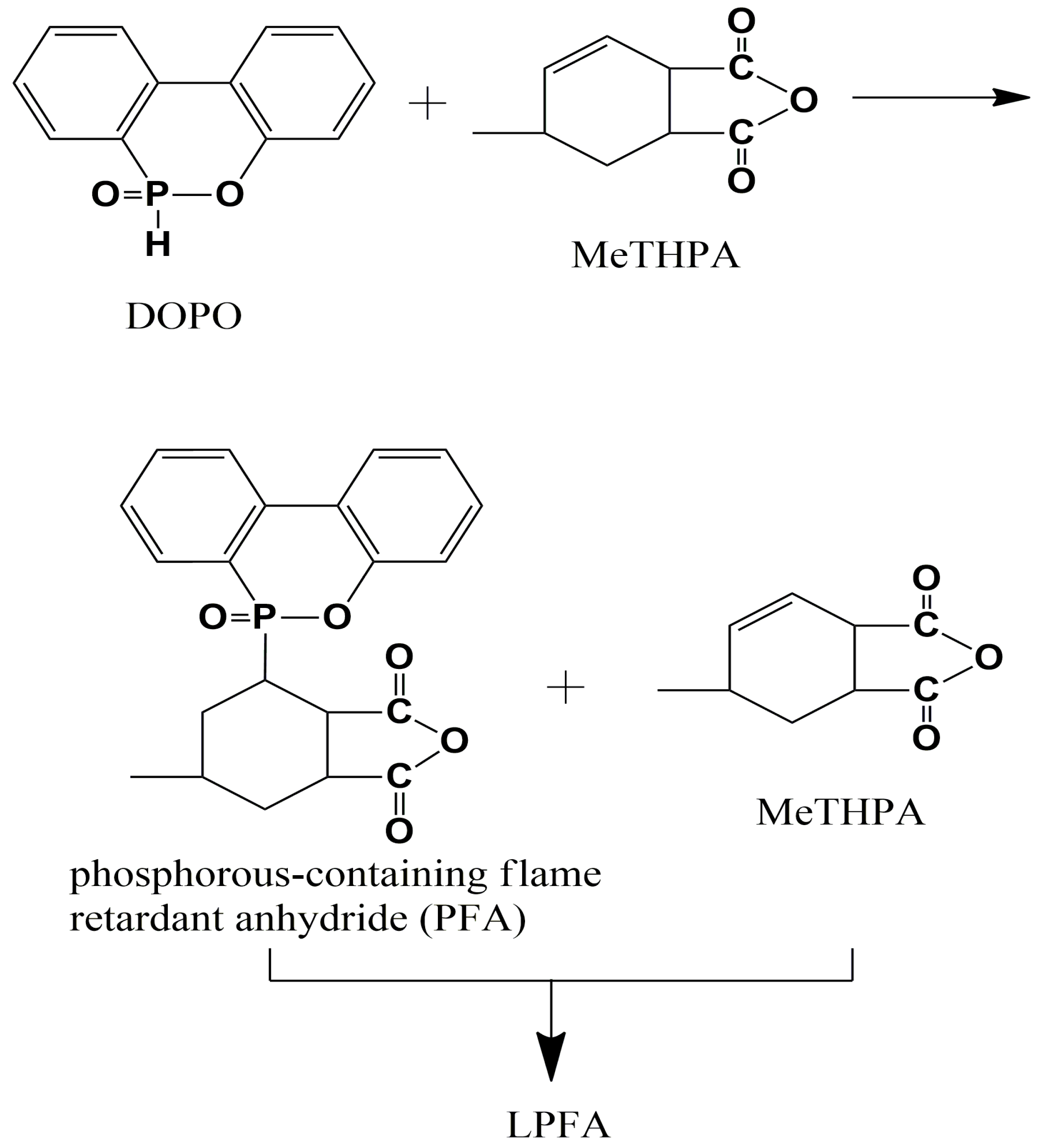

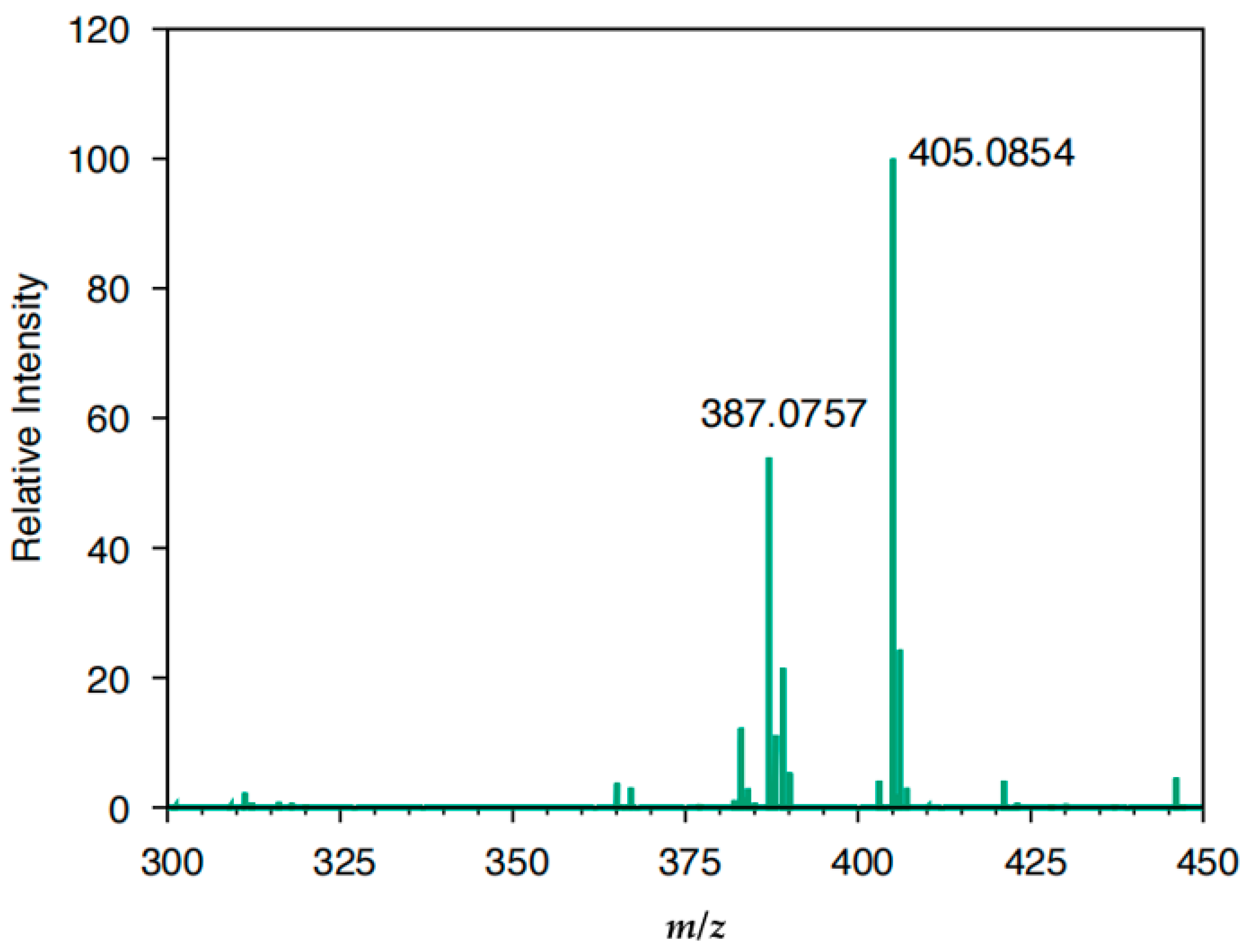
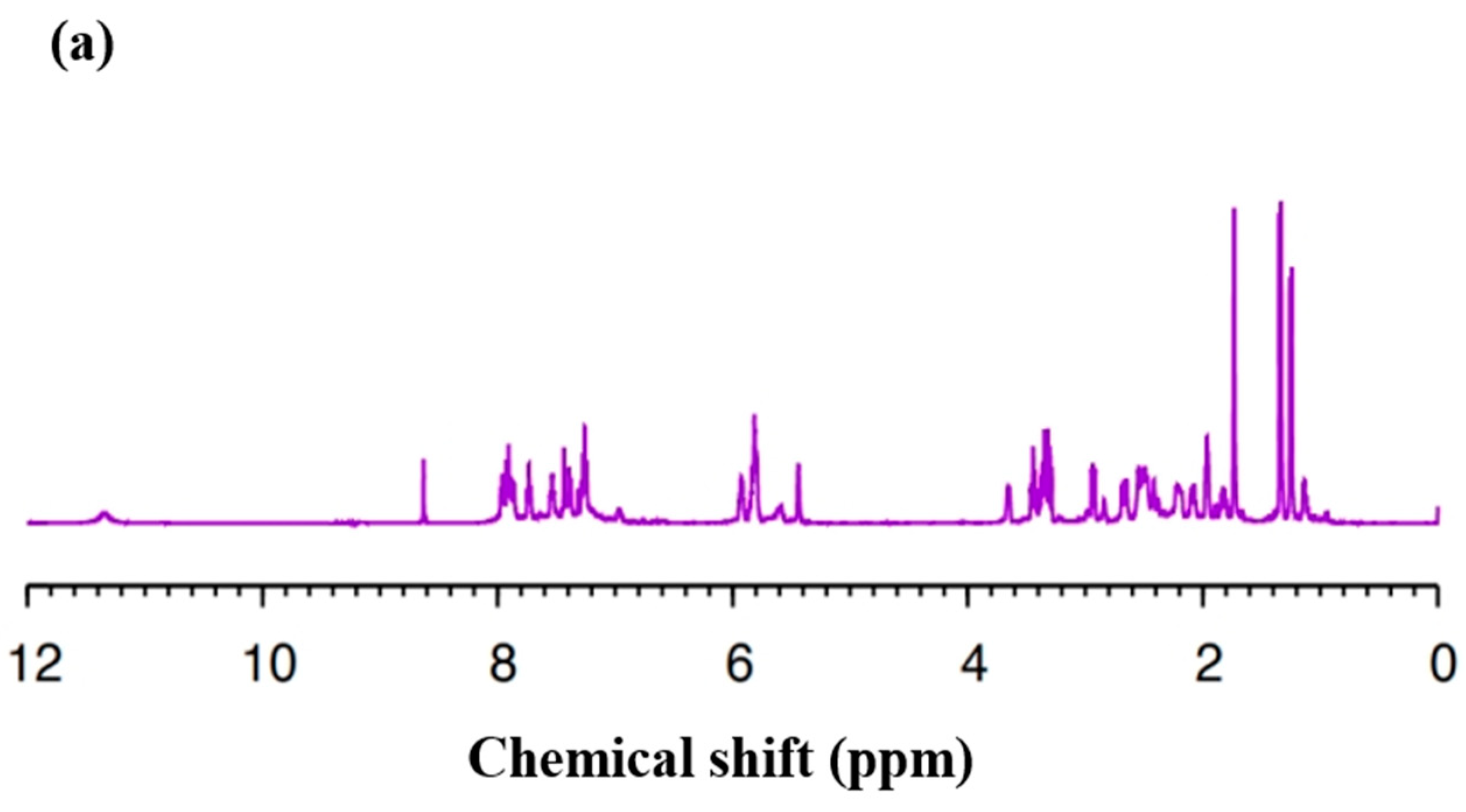



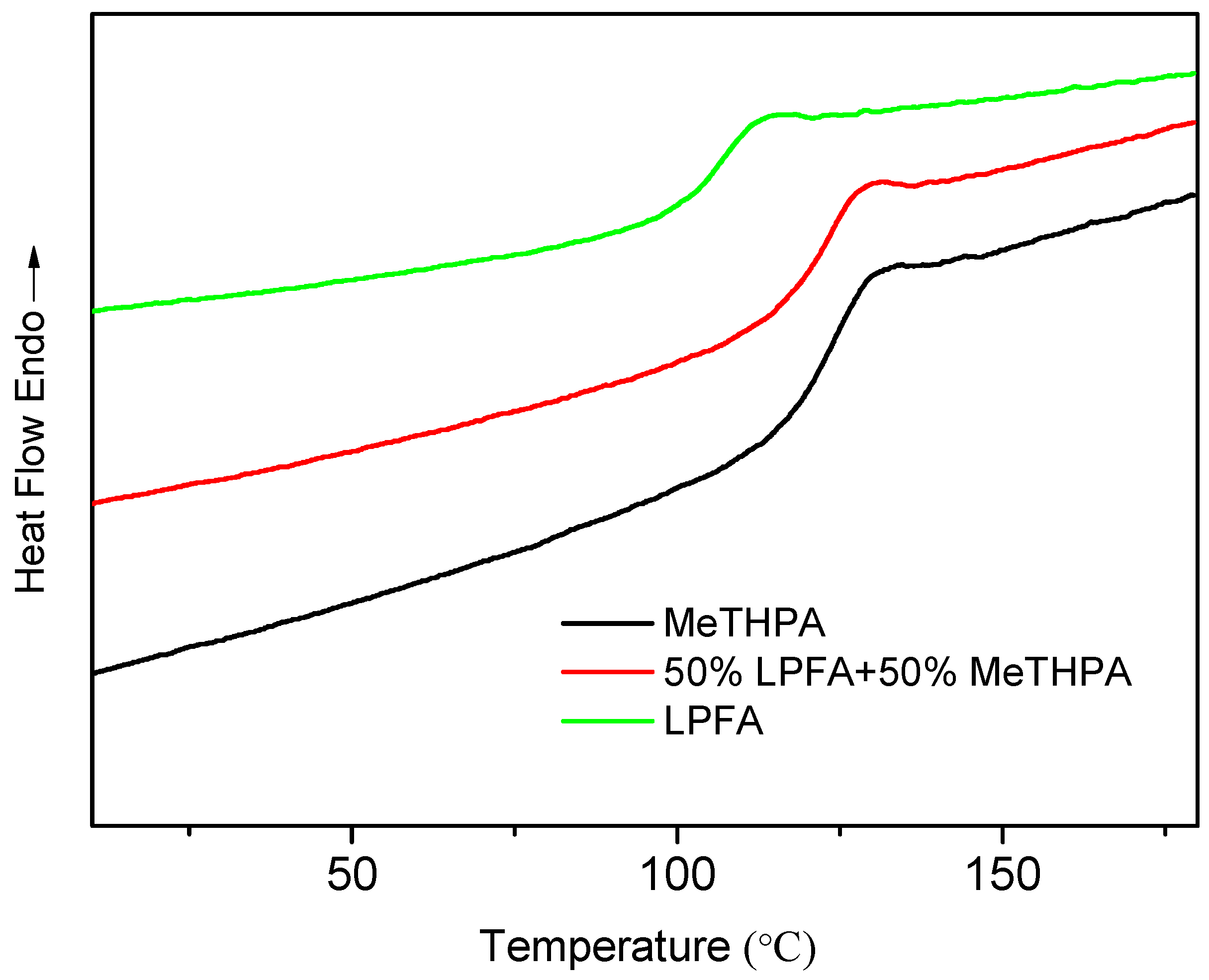
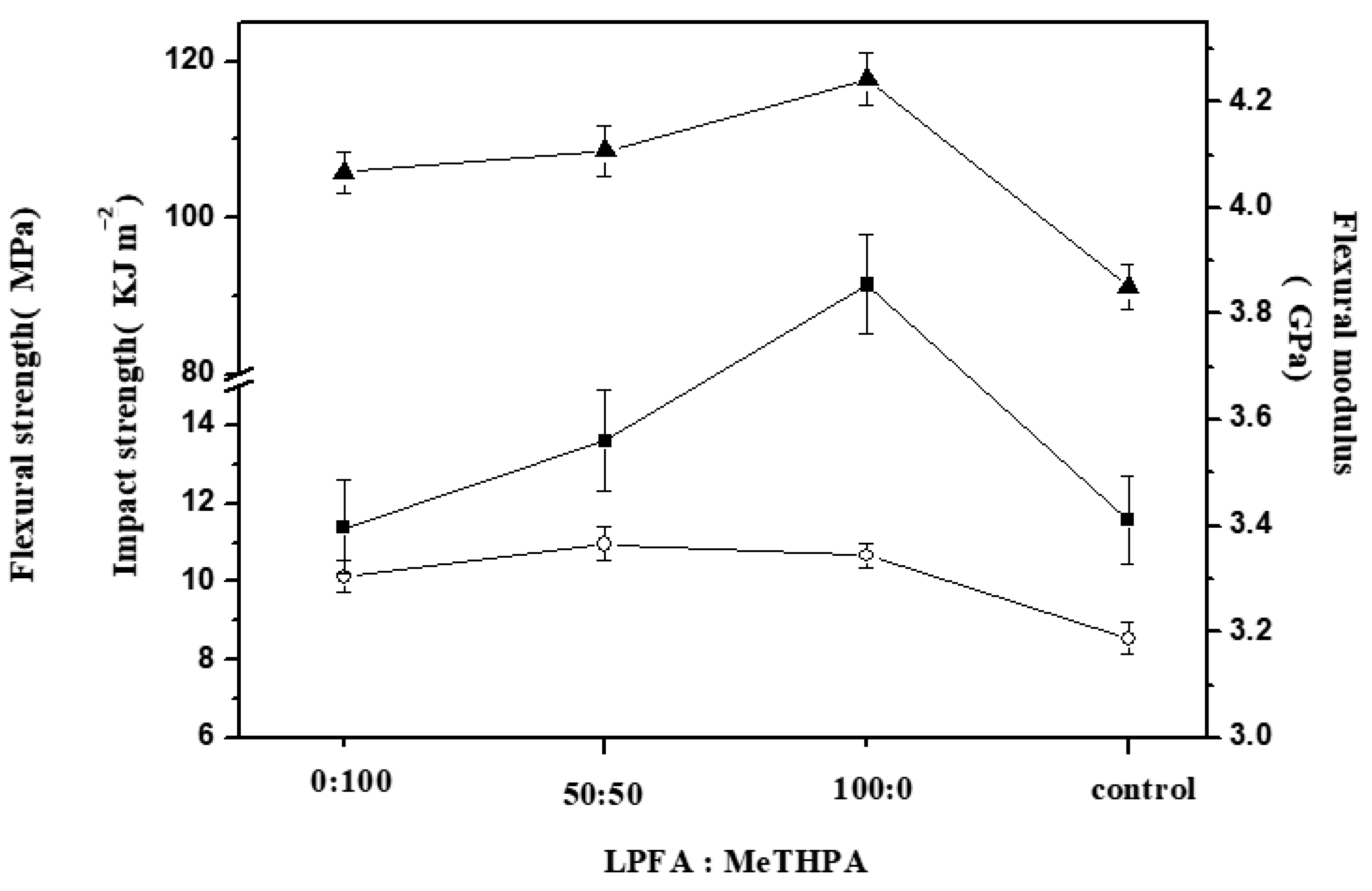
| LPFA:MeTHPA | Phosphorus Content (%) | LOI (%) | Burning Time (s) | UL-94 Rating |
|---|---|---|---|---|
| 0:100 | 0 | 19.9 ± 0.5 | Burning all the time | - |
| 50:50 | 1.20 | 23.9 ± 0.6 | 26 ± 2 | V-2 |
| 70:30 | 1.74 | 26.1 ± 0.5 | 24 ± 2 | V-2 |
| 86:14 | 2.24 | 28.3 ± 0.6 | 15 ± 1 | V-1 |
| 100:0 | 2.70 | 31.2 ± 0.8 | 6 ± 1 | V-0 |
| LPFA:MeTHPA | Temperature of Decomposition Onset (°C) | Temperature of Decomposition the Fastest (°C) | Tg (°C) |
|---|---|---|---|
| 0:100 | 355 | 408 | 105 |
| 50:50 | 330 | 392 | 118 |
| 100:0 | 312 | 385 | 123 |
Publisher’s Note: MDPI stays neutral with regard to jurisdictional claims in published maps and institutional affiliations. |
© 2021 by the authors. Licensee MDPI, Basel, Switzerland. This article is an open access article distributed under the terms and conditions of the Creative Commons Attribution (CC BY) license (https://creativecommons.org/licenses/by/4.0/).
Share and Cite
Li, Q.; Li, Y.; Chen, Y.; Wu, Q.; Wang, S. An Effective Method for Preparation of Liquid Phosphoric Anhydride and Its Application in Flame Retardant Epoxy Resin. Materials 2021, 14, 2205. https://doi.org/10.3390/ma14092205
Li Q, Li Y, Chen Y, Wu Q, Wang S. An Effective Method for Preparation of Liquid Phosphoric Anhydride and Its Application in Flame Retardant Epoxy Resin. Materials. 2021; 14(9):2205. https://doi.org/10.3390/ma14092205
Chicago/Turabian StyleLi, Qian, Yujie Li, Yifan Chen, Qiang Wu, and Siqun Wang. 2021. "An Effective Method for Preparation of Liquid Phosphoric Anhydride and Its Application in Flame Retardant Epoxy Resin" Materials 14, no. 9: 2205. https://doi.org/10.3390/ma14092205






